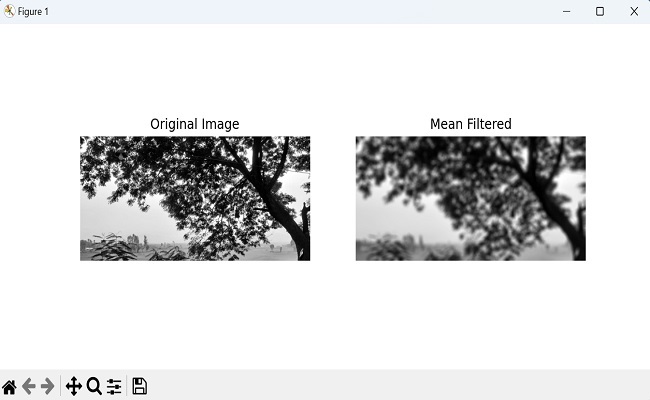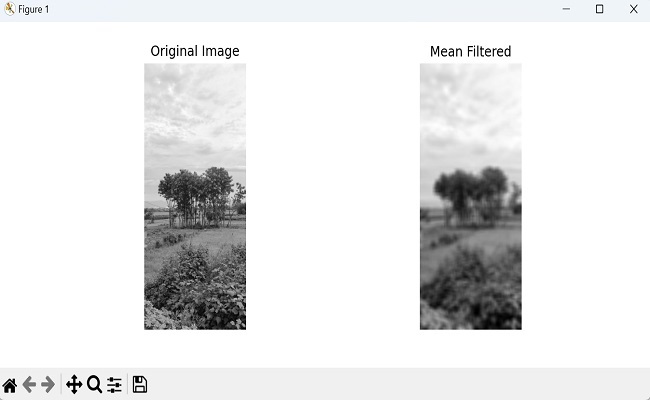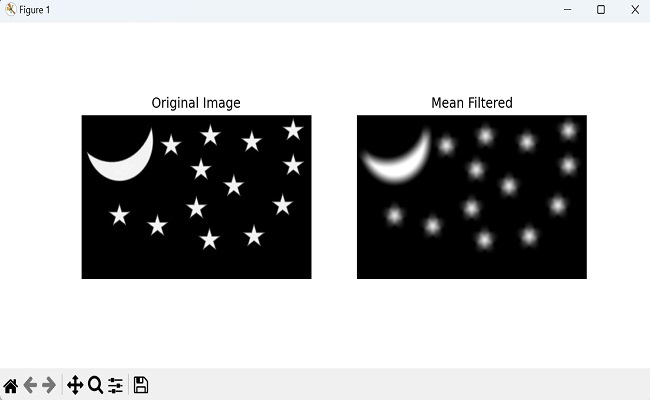
- Mahotas - Home
- Mahotas - Introduction
- Mahotas - Computer Vision
- Mahotas - History
- Mahotas - Features
- Mahotas - Installation
- Mahotas Handling Images
- Mahotas - Handling Images
- Mahotas - Loading an Image
- Mahotas - Loading Image as Grey
- Mahotas - Displaying an Image
- Mahotas - Displaying Shape of an Image
- Mahotas - Saving an Image
- Mahotas - Centre of Mass of an Image
- Mahotas - Convolution of Image
- Mahotas - Creating RGB Image
- Mahotas - Euler Number of an Image
- Mahotas - Fraction of Zeros in an Image
- Mahotas - Getting Image Moments
- Mahotas - Local Maxima in an Image
- Mahotas - Image Ellipse Axes
- Mahotas - Image Stretch RGB
- Mahotas Color-Space Conversion
- Mahotas - Color-Space Conversion
- Mahotas - RGB to Gray Conversion
- Mahotas - RGB to LAB Conversion
- Mahotas - RGB to Sepia
- Mahotas - RGB to XYZ Conversion
- Mahotas - XYZ to LAB Conversion
- Mahotas - XYZ to RGB Conversion
- Mahotas - Increase Gamma Correction
- Mahotas - Stretching Gamma Correction
- Mahotas Labeled Image Functions
- Mahotas - Labeled Image Functions
- Mahotas - Labeling Images
- Mahotas - Filtering Regions
- Mahotas - Border Pixels
- Mahotas - Morphological Operations
- Mahotas - Morphological Operators
- Mahotas - Finding Image Mean
- Mahotas - Cropping an Image
- Mahotas - Eccentricity of an Image
- Mahotas - Overlaying Image
- Mahotas - Roundness of Image
- Mahotas - Resizing an Image
- Mahotas - Histogram of Image
- Mahotas - Dilating an Image
- Mahotas - Eroding Image
- Mahotas - Watershed
- Mahotas - Opening Process on Image
- Mahotas - Closing Process on Image
- Mahotas - Closing Holes in an Image
- Mahotas - Conditional Dilating Image
- Mahotas - Conditional Eroding Image
- Mahotas - Conditional Watershed of Image
- Mahotas - Local Minima in Image
- Mahotas - Regional Maxima of Image
- Mahotas - Regional Minima of Image
- Mahotas - Advanced Concepts
- Mahotas - Image Thresholding
- Mahotas - Setting Threshold
- Mahotas - Soft Threshold
- Mahotas - Bernsen Local Thresholding
- Mahotas - Wavelet Transforms
- Making Image Wavelet Center
- Mahotas - Distance Transform
- Mahotas - Polygon Utilities
- Mahotas - Local Binary Patterns
- Threshold Adjacency Statistics
- Mahotas - Haralic Features
- Weight of Labeled Region
- Mahotas - Zernike Features
- Mahotas - Zernike Moments
- Mahotas - Rank Filter
- Mahotas - 2D Laplacian Filter
- Mahotas - Majority Filter
- Mahotas - Mean Filter
- Mahotas - Median Filter
- Mahotas - Otsu's Method
- Mahotas - Gaussian Filtering
- Mahotas - Hit & Miss Transform
- Mahotas - Labeled Max Array
- Mahotas - Mean Value of Image
- Mahotas - SURF Dense Points
- Mahotas - SURF Integral
- Mahotas - Haar Transform
- Highlighting Image Maxima
- Computing Linear Binary Patterns
- Getting Border of Labels
- Reversing Haar Transform
- Riddler-Calvard Method
- Sizes of Labelled Region
- Mahotas - Template Matching
- Speeded-Up Robust Features
- Removing Bordered Labelled
- Mahotas - Daubechies Wavelet
- Mahotas - Sobel Edge Detection
Mahotas - Mean Filter
The mean filter is used to smooth out an image to reduce noise. It works by calculating the average value of all the pixels within a specified neighborhood and then, replaces the value of the original pixel with the average value.
Let's imagine we have a grayscale image with varying intensity values. Hence, some pixels may have a higher intensity value than other pixels.
Thus, the mean filter is used to create a uniform appearance of the pixels by slightly blurring the image.
Mean Filter in Mahotas
To apply the mean filter in mahotas, we can use the mean_filter() function.
The mean filter in Mahotas uses a structuring element to examine pixels in a neighborhood.
The structuring element replaces each value of pixel with the average value of its neighbouring pixels.
The size of the structuring element determines the extent of smoothing. A larger neighborhood results in stronger smoothing effect, while reducing some finer details, whereas a smaller neightborhood results in less smoothing but maintains more details.
The mahotas.mean_filter() function
The mean_filter() function applies the mean filter to the input image using the specified neighborhood size.
It replaces each pixel value with the majority value among its neighbors. The filtered image is stored in the output array.
Syntax
Following is the basic syntax of the mean filter() function in mahotas −
mahotas.mean_filter(f, Bc, mode='ignore', cval=0.0, out=None)
Where,
img − It is the input image.
Bc − It is the structuring element that defines the neighbourhood.
-
mode (optional) − It specifies how the function handles the borders of the image. It can take different values such as 'reflect', 'constant', 'nearest', 'mirror' or 'wrap'.
By default, it is set to 'ignore', which means the filter ignores pixels beyond the image's borders.
cval (optional) − The value to be used when mode='constant'. The default value is 0.0.
out (optional) − It specifies the output array where the filtered image will be stored. It must be of the same shape as the input image.
Example
Following is the basic example to filter the image using the mean_filter() function −
import mahotas as mh
import numpy as np
import matplotlib.pyplot as mtplt
image=mh.imread('tree.tiff', as_grey = True)
structuring_element = mh.disk(12)
filtered_image = mh.mean_filter(image, structuring_element)
# Displaying the original image
fig, axes = mtplt.subplots(1, 2, figsize=(9, 4))
axes[0].imshow(image, cmap='gray')
axes[0].set_title('Original Image')
axes[0].axis('off')
# Displaying the mean filtered image
axes[1].imshow(filtered_image, cmap='gray')
axes[1].set_title('Mean Filtered')
axes[1].axis('off')
mtplt.show()
Output
After executing the above code, we get the following output −

Mean Filter with Reflect Mode
When we apply the mean filter to an image, we need to consider the neighboring pixels around each pixel to calculate the average. However, at the edges of the image, there are pixels that don't have neighbors on one or more sides.
To address this issue, we use the 'reflect' mode. Reflect mode creates a mirror−like effect along the edges of the image. It allows us to virtually extend the image by duplicating its pixels in a mirrored manner.
This way, we can provide the mean filter with neighboring pixels even at the edges.
By reflecting the image values, the mean filter can now consider these mirrored pixels as if they were real neighbors.
It calculates the average value using these virtual neighbors, resulting in a more accurate smoothing process at the image edges.
Example
In here, we are trying to calculate the mean filter with the reflect mode −
import mahotas as mh
import numpy as np
import matplotlib.pyplot as mtplt
image=mh.imread('nature.jpeg', as_grey = True)
structuring_element = mh.morph.dilate(mh.disk(12), Bc=mh.disk(12))
filtered_image = mh.mean_filter(image, structuring_element, mode='reflect')
# Displaying the original image
fig, axes = mtplt.subplots(1, 2, figsize=(9, 4))
axes[0].imshow(image, cmap='gray')
axes[0].set_title('Original Image')
axes[0].axis('off')
# Displaying the mean filtered image
axes[1].imshow(filtered_image, cmap='gray')
axes[1].set_title('Mean Filtered')
axes[1].axis('off')
mtplt.show()
Output
Output of the above code is as follows −

By Storing Result in an Output Array
We can store the result of the mean filter in an output array as well using Mahotas. To achieve this, we first need to create an empty array using the NumPy library.
This array is initialized with the same shape as the input image to store the resultant filtered image. The data type of the array is specified as float (default).
Finally, we store the resultant filtered image in the output array by passing it as a parameter to the mean_filter() function.
Example
Now, we are trying to apply mean filter to a grayscale image and store the result in a specific output array −
import mahotas as mh
import numpy as np
import matplotlib.pyplot as mtplt
image=mh.imread('pic.jpg', as_grey = True)
# Create an output array for the filtered image
output = np.empty(image.shape)
# store the result in the output array
mh.mean_filter(image, Bc=mh.disk(12), out=output)
# Displaying the original image
fig, axes = mtplt.subplots(1, 2, figsize=(9, 4))
axes[0].imshow(image, cmap='gray')
axes[0].set_title('Original Image')
axes[0].axis('off')
# Displaying the mean filtered image
axes[1].imshow(output, cmap='gray')
axes[1].set_title('Mean Filtered')
axes[1].axis('off')
mtplt.show()
Output
Following is the output of the above code −
